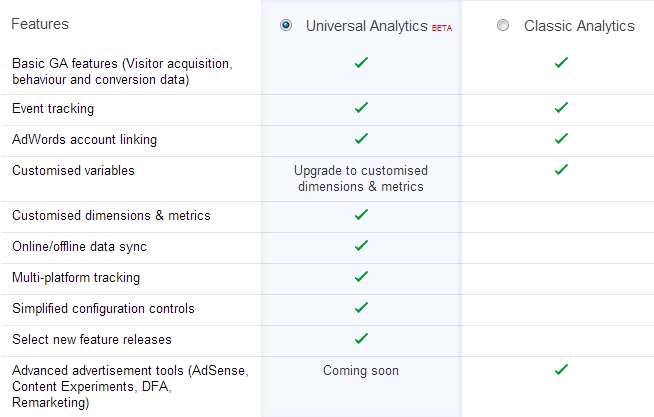Since the launch of Google Analytics solution (GA) in 2005, our user interface is constantly changing, improving, and integrating more and more aspects of the massive "Big Data". It became even more important with the latest changes in customer behaviour and multi-device navigation issues. GA seems now the most suitable free technology to track user behaviour and catch some powerful insight for a website. In fact, we estimate that 70% of website is GA tagged and that represents one page out of two on the web.
A LITTLE BIT OF HISTORY
Let us dwell briefly on the evolution of the Analytics tag before analysing its new version: the Universal tag. Initially, we started with the Urchin tag (urchin.js), ancestor of the Analytics tag from the program of the same name. It was replaced in December 2007 by its upgrade, the synchronous Google Analytics tag (ga.js with pageTracker) that offered more opportunities with a simplified version. It took 2 years before we could see the appearance of the asynchronous version (ga.js with _gaqpush) in December 2009 that reduced the overall page load time. Shortly after, the DoubleClick® (dc.js) version appeared and enhanced our targeting options for Google AdWords Remarketing. And finally in October 2012, Google announced the arrival of a new powered tag (analytics.js) providing a host of additional reports and metrics.
NEW FEATURES
In fact, with this new version, it is now possible to customize some of the GA data’s:
-
Create your own metrics tailored to your Analytics needs
-
Rename SEO sources in reports
-
Set a specific time length for campaigns
-
Exclude referring sites and / or undesirable SEO requests
-
In-depth follow-up of mobile applications (installation / content / ...)
-
A maximum of 20 custom variables (instead of five in the previous version)
The benefits of this new tracking method are multiple. On the one hand it allows us to follow a "client" adequately and secondly, it enables advertisers to link offline activities, such as selling store or phone call to the call-centre, to online behaviour of a user. In addition, with the Measurement Protocol you will be able to send requests directly to the GA servers. Thus, additional external / offline data’s, such as age, gender, etc. will find their right place in the interface. With such features, the famous debate of Attribution Modelling is therefore enriched. The web analysts are thus thrilled to see much clearer in the full customer's buying cycle, from the online engagement to the offline purchase. It is also important to note that we are switching from a 4 cookies _utm system to a single cookie _ga system used for customer identification. It allows advertisers to target / segment more precisely their audience through unique identifiers.
UNIVERSAL TAG AND PRIVACY
Unique identifier… But what about private life then? Does it not jeopardize the integrity, privacy of users? Absolutely not! The new version has kept the old Google privacy principles. All personally identifiable information (PII) is protected as in previous versions. In addition, IP masking and additional privacy modules will always be working on the new universal tag. A slight change though on websites hosting GA new Universal Tag: they are now obliged to inform the visitor of its implementation and give him the choice (explicit agreement with tracking or total refusal).
NEXT STEPS
As the Universal properties are still in Beta, we suggest to wait a little bit more before switching to the new version. Firstly, some bugs and features are still worked out by the Engineers team (see snapshot hereunder). And secondly, the topic is to be discussed in the next GACP monthly call so we will have more details in September. As certified partners, we will keep you posted on the best practices for a Roadmap to migration. So keep your eyes and ears open, because the sooner it will be implemented, the sooner you can take advantage of new features.

As far as data’s are concerned, the upgrade will maintain visitor history and all historical account data’s. Nevertheless, you still have two choices: either to create a new Universal property or to wait to be updated automatically (October 2013). If you are hasty or dying of curiosity and choose to create a new property, note that the two versions of tags are compatible, they can work together during the transition. And if you use the Tag Manager, it will be smoother and easier to implement. Finally, and as usual, Google offers this new version free of charge unless you need more than 20 customizable variables (rather than 5 as in the old version) or if your site triggers more than a billion "hit" per month (Pageviews / Events / Transactions).
With this latest upgrade, Google shows us once again that "the sky is the limit”!


